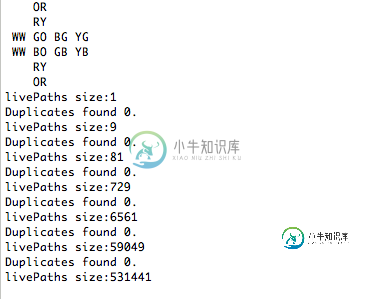获取非重写的equals方法以使用hashCode

这是来自与hashCode一起使用的旧版本代码并等于,但我正在尝试让新版本使用它。我认为原因是因为在旧版本中我覆盖了 equals 和 hashCode,但在新版本中我似乎无法做到这一点,因为我不再比较对象,而是比较数组(这是猜测)。因此,当前版本不会拾取重复项。它说没有重复项,但这是不正确的。

以下是检测重复项的旧版本的哈希代码和等于。
private Cube() {
cube = new int[][] {
{ 0, 0, 0, 0 },
{ 1, 1, 1, 1 },
{ 2, 2, 2, 2 },
{ 3, 3, 3, 3 },
{ 4, 4, 4, 4 },
{ 5, 5, 5, 5 }
};
cube = scanCube(cube);
cube = print_cube(cube);
}
private Cube(Cube other) {
cube = new int[other.cube.length][];
for (int i = 0; i < other.cube.length; i++) {
cube[i] = Arrays.copyOf(other.cube[i], other.cube[i].length);
}
}
public boolean isSolved() {
for (int i = 0; i < cube.length; i++) {
for (int k = 1; k < cube[i].length; k++) {
if (cube[i][0] != cube[i][k]) {
return false;
}
}
}
return true;
}
@Override
public boolean equals(Object other) {
return other instanceof Cube && Arrays.deepEquals(((Cube) other).cube, cube);
}
@Override
public int hashCode() {
return Arrays.deepHashCode(cube);
}`
这是当前版本。
public static void main(String[] args) {
int[][] cube = new int[][] {
{ 0, 0, 0, 0 },
{ 1, 1, 1, 1 },
{ 2, 2, 2, 2 },
{ 3, 3, 3, 3 },
{ 4, 4, 4, 4 },
{ 5, 5, 5, 5 }
};
cube = scanCube(cube);
cube = print_cube(cube);
solve(cube);
}
private static boolean isSolved(int [][] cube) {
for (int i = 0; i < cube.length; i++) {
for (int k = 1; k < cube[i].length; k++) {
if (cube[i][0] != cube[i][k]) {
return false;
}
}
}
return true;
}
public static int[][] copyCube(int [][] cube){
int [][] copy = new int [6][4];
for(int i = 0; i < 6; i++ ){
copy[i] = cube[i].clone();
}
return copy;
}
public static boolean equals(int[][] other, int[][] cube) {
return Arrays.deepEquals(other, cube);
}
public int hashCode(int [][] cube) {
return Arrays.deepHashCode(cube);
}
在搜索方法中是确定重复项的地方。这是旧的代码。
static public void solve(Cube c) {
Set<Cube> cubesFound = new HashSet<Cube>();
cubesFound.add(c);
Stack<Cube> s = new Stack<Cube>();
s.push(c);
Set<Stack<Cube>> initialPaths = new HashSet<Stack<Cube>>();
initialPaths.add(s);
solve(initialPaths, cubesFound);
}
static public void solve(Set<Stack<Cube>> livePaths, Set<Cube> cubesFoundSoFar) {
System.out.println("livePaths size:" + livePaths.size());
int numDupes = 0;
Set<Stack<Cube>> newLivePaths = new HashSet<Stack<Cube>>();
for (Stack<Cube> currentPath : livePaths) {
Set<Cube> nextStates = currentPath.peek().getNextStates();
for (Cube next : nextStates) {
if (currentPath.size() > 1 && next.isSolved()) {
currentPath.push(next);
System.out.println("Path length:" + currentPath.size());
System.out.println("Path:" + currentPath);
System.exit(0);
} else if (!cubesFoundSoFar.contains(next)) {
Stack<Cube> newCurrentPath = new Stack<Cube>();
newCurrentPath.addAll(currentPath);
newCurrentPath.push(next);
newLivePaths.add(newCurrentPath);
cubesFoundSoFar.add(next);
} else {
numDupes += 1;
}
}
}
System.out.println("Duplicates found " + numDupes + ".");
solve(newLivePaths, cubesFoundSoFar);
}
还有新的。
static private void solve(int[][] cube) {
int[][][] s = new int[12][6][4];
s[0] = cube;
Set<int[][][]> initialPaths = new HashSet<int[][][]>();
initialPaths.add(s);
Set<int[][]> cubesFound = new HashSet<int[][]>();
cubesFound.add(cube);
solve(initialPaths, cubesFound, 1);
}
static private void solve(Set<int[][][]> livePaths,Set<int[][]> cubesFoundSoFar, int iterationCount) {
System.out.println("livePaths size:" + livePaths.size());
Set<int[][][]> newLivePaths = new HashSet<int[][][]>();
int counter = 0;
int recordDepth = 0;
int duplicates = 0;
for(int[][][] currentPath : livePaths) {
Set<int [][]> nextStates = getNextStates(currentPath[iterationCount-1]);
for (int[][] next : nextStates) {
if (isSolved(next)) {
currentPath[iterationCount] = next;
int maxSteps = -1;
System.out.println("Path:" );
for(int i = 0; i < currentPath.length; i++) {
if(currentPath[i] != null) {
maxSteps = i;
System.out.println(toString(currentPath[i]));
}else {
break;
}
}
System.out.println("Path length:" + maxSteps);
System.exit(0);
} else if(!cubesFoundSoFar.contains(next)){
int[][][] newCurrentPath = new int[12][6][4];
newCurrentPath = currentPath.clone();
newCurrentPath[iterationCount] = next;
newLivePaths.add(newCurrentPath);
counter ++;
cubesFoundSoFar.add(next);
} else {
duplicates += 1;
}
}
}
//System.out.println(" Set.size(): "+newLivePaths.size());
String storeStates = "positions.txt";
try {
PrintWriter outputStream = new PrintWriter(storeStates);
outputStream.println(storeStates);
for(int[][][] s:newLivePaths) {
outputStream.println(toString(s[iterationCount]));
}
outputStream.close();
} catch (FileNotFoundException e) {
System.err.println("Fatal: could not open cache file for cube positions. exiting.");
e.printStackTrace();
System.exit(1);
}
System.out.println("Duplicates found "+ duplicates + ".");
solve(newLivePaths, cubesFoundSoFar, iterationCount+1);
}
共有1个答案
您没有在第二个代码中重写< code>equals(Object)方法,但是< code > set . contains(Object)使用< code>equals来比较元素。因为多维数据集中没有对象,所以使用< code>Object的对象。这并不比较内容,它只是测试对象是否是相同的实例(相同的内存位置)。
此处的相关部分包含:
...更正式地说,当且仅当此集合包含元素 e 时返回 true,使得 (o==null ? e==null : o.equals(e))。...
您可以在第二个代码中添加类似的内容:
@Override
public boolean equals(Object other) {
if (other instanceof Cube)
return equals(cube, ((Cube) other).cube);
else
return false;
}
@Override
public int hashCode() {
return hashCode(cube);
}
-
问题内容: 如何覆盖对象类中的equals方法? 即我有 我想将参数obj转换为Person类型,但是如果执行(Person)obj,它将无法正常工作。 问题答案: 您可以将其强制转换为方法,只需使用的实例确保其类型正确
-
我正在尝试创建一个有理数类并覆盖等于和哈希代码方法。但是我的等号在明显不正确的情况下又回来了,即分子和分母不同。知道是什么原因造成的吗?
-
本文向大家介绍hashCode 与 equals ?为什么重写equals时必须重写hashCode方法?相关面试题,主要包含被问及hashCode 与 equals ?为什么重写equals时必须重写hashCode方法?时的应答技巧和注意事项,需要的朋友参考一下 面试官可能会问你:“你重写过 hashcode 和 equals 么,为什么重写equals时必须重写hashCode方法?” ha
-
本文向大家介绍java中重写equals()方法的同时要重写hashcode()方法(详解),包括了java中重写equals()方法的同时要重写hashcode()方法(详解)的使用技巧和注意事项,需要的朋友参考一下 object对象中的 public boolean equals(Object obj),对于任何非空引用值 x 和 y,当且仅当 x 和 y 引用同一个对象时,此方法才返回 tr
-
本文向大家介绍为什么在重写 equals方法的同时必须重写 hashcode方法,包括了为什么在重写 equals方法的同时必须重写 hashcode方法的使用技巧和注意事项,需要的朋友参考一下 我们都知道Java语言是完全面向对象的,在java中,所有的对象都是继承于Object类。 其 equals 方法比较的是两个对象的引用指向的地址,hashcode 是一个本地方法,返回的是对象地址值。O
-
我的问题是关于我被重写的hashCode()方法。我知道,如果equals(Object)方法认为两个对象相等,我需要hashCode()为它们返回相同的值。我的直觉告诉我,在某些情况下,这个hashCode()会违反合同。 有没有一种可接受的方法可以在一个重写的equals(Object)方法中使用equalsIgnoreCase(String)方法,并生成一个不违反约定的hashcode?

